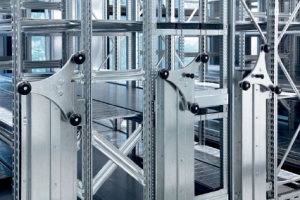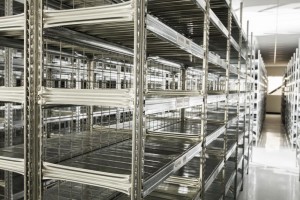Top 10 ways to plan your warehouse or distribution centre
In today’s competitive business climate, with the global economy just beginning to recover, it is more important than ever for business owners to realize as many enterprise-wide efficiencies as possible to drive profits and growth. This includes not only research and development, but manufacturing, marketing, distribution, accounting, human resources, and what sort of shelving system is best suited for a warehouse or distribution centre.
As the leading storage solutions company in the Greater Toronto Area, Metalsistem Canada is uniquely qualified to help business owners find affordable, high quality, and configurable shelving systems to meet their needs. We are famous not only for our attention to detail, but outstanding customer service and value.
To find the right industrial storage shelving for your business, each owner, manager, or design consultant must look at factors unique to that business. In a large scale enterprise, an off-the-shelf, “cookie cutter” type solution is not only unsuitable for specific needs, but also could be costly in the long run due to inefficiencies and the need to find replacement systems as the business grows.
Here are the top 10 Ways to Plan for Your Warehouse or Distribution Centre.
- Develop a budget and stick to it. Business owners sometimes make the mistake of not planning their budget, or taking into consideration previous expenditures and projected expenses. Forecasting is critical to planning, and must occur before buying decisions are made related to a particular shelving system or other storage product. In doing so, it is always advisable to include a line item for “other contingencies” – or unexpected expenses that may arise if the warehouse begins stocking products of a certain dimension, weight, or type that were not planned for originally.
- Put goals and objectives in writing. Each of these should coincide with the broader business goal of profitability, but specific items to think about include: Minimizing warehouse operating expenses, increasing storage space and accessibility, maximizing available storage and configuring for future growth, and achieving each of these with the lowest expense in terms of labor and other resources.
- Document the process, from start to finish. Just as a house or office building cannot be constructed without plans, planning for your warehouse or distribution centre and required industrial storage shelving will fail without the process being documented. This means interviewing warehouse staff about how they do their jobs, how product flows in and out, where items are stored, and how the operation can become more efficient. Not speaking with the people actually doing the work is a critical failure point for any business.
- Collect information and data related to existing space, forecasts for additional space, staffing requirements, dock locations, entrance and egress points, and environmental concerns – such as whether or not stored items have certain heating, cooling, or other environmental needs. This is especially important when selecting a shelving system for cold storage of food, chemicals, or other items with expiration dates.
- Analysis. Now that a budget has been established, goals have been determined, the warehouse operations have been documented, and other data has been collected, the next step is analyzing the overall information and whether or not the plan can be realized. Keys items to consider in this regard include: Product flow, docking, reviewing industrial storage shelving options, sorting equipment, staffing levels, training needs, the effect on other departments, and will the warehouse benefit from such systems.
- Create a detailed project plan. This should encompass all facets of creating an optimum warehouse or distribution centre, taking into consideration not only the planning process, but the physical requirements as well. In this regard, it is advisable to work with a business process professional with experience in warehouse efficiencies, and one certified from the Project Management Institute (PMI). A PMI-certified project manager has the experience and business expertise necessary to create a detailed project plan that will include tasks, milestones, staffing, hours estimate, budget, and deadline.
- Find an executive sponsor within the company. Industrial storage shelving is important in any warehouse setting, but getting the facility up and running also requires the oversight and decision making powers from a senior level executive who will approve plans, sign off on each step of the process, and make other key decisions as necessary. This person may not be involved in minute details, but has the experience and authority to break through inertia that happens with large, enterprise wide projects.
- Implementation. The implementation phase of the project is where all plans transition from concept to reality, where risks are mitigated, new processes are put in place, and the overall goals and objectives are met.
- Ongoing Management. Even in the most technologically controlled warehouse environments, ongoing, physical management is necessary to gauge how well the storage facility operates, use benchmarks to determine success, and suggest ways to improve process flows.
- Post Project Review. Once a warehouse or distribution centre is up and running, it is not unusual for a Post Project Review to take place. The goal is not necessarily to look at corporate profitability related to the new storage space, but rather how the plan developed and was implemented. This review is normally led by the executive or other senior level manager, and requires input from staff that is critical to the supply chain process, from forklift operators to dock supervisors or other employees.
Succeeding in any business can be time consuming, expensive, and require knowledge, experience, and other resources that many businesses fail to consider before constructing a warehouse or other storage facility. At Metalsistem Canada, we are committed to helping businesses find unique and affordable industrial storage shelving for all their needs, regardless of scope or budget.







